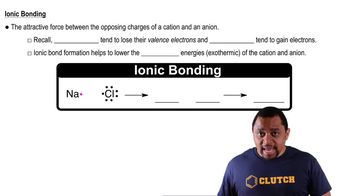Ch.22 - Chemistry of the Nonmetals
Chapter 22, Problem 84
Complete the exercises below. A sulfuric acid plant produces a considerable amount of heat. This heat is used to generate electricity, which helps reduce operating costs. The synthesis of H₂SO₄ consists of three main chemical processes: a. oxidation of S to SO₂, b. oxidation of SO₂ to SO₃, c. the dissolving of SO₃ in H₂SO₄ and the subsequent reaction with water to form H₂SO₄. If the third process produces 130 kJ/mol, how much heat is produced in preparing a mole of H₂SO₄ from a mole of S? How much heat is produced in preparing 5000 pounds of H₂SO₄?
 Verified step by step guidance
Verified step by step guidance1
Step 1: Identify the chemical reactions involved in the synthesis of H₂SO₄. The reactions are: (a) S + O₂ → SO₂, (b) 2 SO₂ + O₂ → 2 SO₃, (c) SO₃ + H₂O → H₂SO₄.
Step 2: Determine the enthalpy change for each reaction. You are given that the third process produces 130 kJ/mol. You will need to find or be given the enthalpy changes for the first two reactions to calculate the total heat produced.
Step 3: Calculate the total heat produced per mole of H₂SO₄ by summing the enthalpy changes of the three reactions. This will give you the total heat produced when one mole of sulfur is converted to one mole of H₂SO₄.
Step 4: Convert 5000 pounds of H₂SO₄ to moles. Use the molar mass of H₂SO₄ (approximately 98.08 g/mol) and the conversion factor from pounds to grams (1 pound = 453.592 grams) to find the number of moles.
Step 5: Calculate the total heat produced for 5000 pounds of H₂SO₄ by multiplying the number of moles calculated in Step 4 by the total heat produced per mole from Step 3.
Key Concepts
Here are the essential concepts you must grasp in order to answer the question correctly.
Thermochemistry
Thermochemistry is the study of the heat energy associated with chemical reactions and changes of state. It involves understanding how energy is absorbed or released during chemical processes, which is crucial for calculating the heat produced or consumed in reactions, such as the formation of sulfuric acid from sulfur.
Recommended video:
Guided course

Chemical Bonds
Stoichiometry
Stoichiometry is the branch of chemistry that deals with the quantitative relationships between the reactants and products in a chemical reaction. It allows us to calculate the amounts of substances involved in reactions, which is essential for determining how much heat is produced when synthesizing sulfuric acid from sulfur.
Recommended video:
Guided course

Stoichiometry Concept
Calorimetry
Calorimetry is the measurement of heat transfer during chemical reactions or physical changes. It provides the tools and methods to quantify the heat produced or absorbed, such as the 130 kJ/mol released in the formation of sulfuric acid, enabling calculations for larger quantities like 5000 pounds of H₂SO₄.
Recommended video:
Guided course

Constant-Volume Calorimetry
Related Practice
